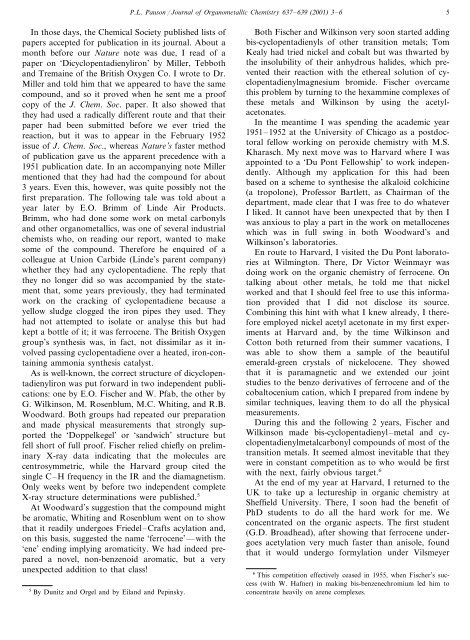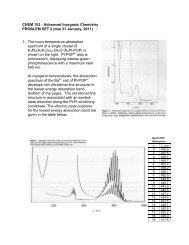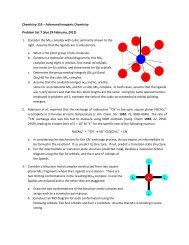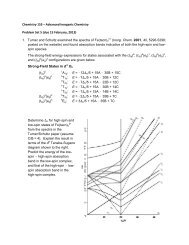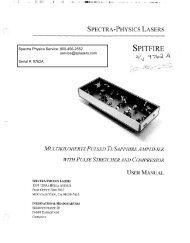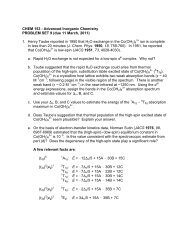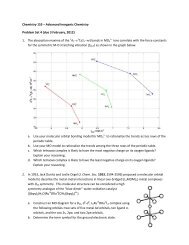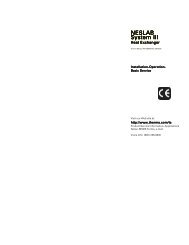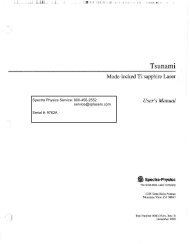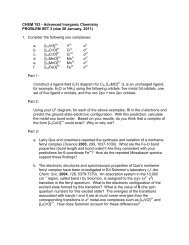Ferroceneâhow it all began
Ferroceneâhow it all began
Ferroceneâhow it all began
You also want an ePaper? Increase the reach of your titles
YUMPU automatically turns print PDFs into web optimized ePapers that Google loves.
P.L. Pauson / Journal of Organomet<strong>all</strong>ic Chemistry 637–639 (2001) 3–6 5In those days, the Chemical Society published lists ofpapers accepted for publication in <strong>it</strong>s journal. About amonth before our Nature note was due, I read of apaper on ‘Dicyclopentadienyliron’ by Miller, Tebbothand Tremaine of the Br<strong>it</strong>ish Oxygen Co. I wrote to Dr.Miller and told him that we appeared to have the samecompound, and so <strong>it</strong> proved when he sent me a proofcopy of the J. Chem. Soc. paper. It also showed thatthey had used a radic<strong>all</strong>y different route and that theirpaper had been subm<strong>it</strong>ted before we ever tried thereaction, but <strong>it</strong> was to appear in the February 1952issue of J. Chem. Soc., whereas Nature’s faster methodof publication gave us the apparent precedence w<strong>it</strong>h a1951 publication date. In an accompanying note Millermentioned that they had had the compound for about3 years. Even this, however, was qu<strong>it</strong>e possibly not thefirst preparation. The following tale was told about ayear later by E.O. Brimm of Linde Air Products.Brimm, who had done some work on metal carbonylsand other organomet<strong>all</strong>ics, was one of several industrialchemists who, on reading our report, wanted to makesome of the compound. Therefore he enquired of acolleague at Union Carbide (Linde’s parent company)whether they had any cyclopentadiene. The reply thatthey no longer did so was accompanied by the statementthat, some years previously, they had terminatedwork on the cracking of cyclopentadiene because ayellow sludge clogged the iron pipes they used. Theyhad not attempted to isolate or analyse this but hadkept a bottle of <strong>it</strong>; <strong>it</strong> was ferrocene. The Br<strong>it</strong>ish Oxygengroup’s synthesis was, in fact, not dissimilar as <strong>it</strong> involvedpassing cyclopentadiene over a heated, iron-containingammonia synthesis catalyst.As is well-known, the correct structure of dicyclopentadienylironwas put forward in two independent publications:one by E.O. Fischer and W. Pfab, the other byG. Wilkinson, M. Rosenblum, M.C. Wh<strong>it</strong>ing, and R.B.Woodward. Both groups had repeated our preparationand made physical measurements that strongly supportedthe ‘Doppelkegel’ or ‘sandwich’ structure butfell short of full proof. Fischer relied chiefly on preliminaryX-ray data indicating that the molecules arecentrosymmetric, while the Harvard group c<strong>it</strong>ed thesingle C–H frequency in the IR and the diamagnetism.Only weeks went by before two independent completeX-ray structure determinations were published. 5At Woodward’s suggestion that the compound mightbe aromatic, Wh<strong>it</strong>ing and Rosenblum went on to showthat <strong>it</strong> readily undergoes Friedel–Crafts acylation and,on this basis, suggested the name ‘ferrocene’—w<strong>it</strong>h the‘ene’ ending implying aromatic<strong>it</strong>y. We had indeed prepareda novel, non-benzenoid aromatic, but a veryunexpected add<strong>it</strong>ion to that class!5By Dun<strong>it</strong>z and Orgel and by Eiland and Pepinsky.Both Fischer and Wilkinson very soon started addingbis-cyclopentadienyls of other trans<strong>it</strong>ion metals; TomKealy had tried nickel and cobalt but was thwarted bythe insolubil<strong>it</strong>y of their anhydrous halides, which preventedtheir reaction w<strong>it</strong>h the ethereal solution of cyclopentadienylmagnesiumbromide. Fischer overcamethis problem by turning to the hexammine complexes ofthese metals and Wilkinson by using the acetylacetonates.In the meantime I was spending the academic year1951–1952 at the Univers<strong>it</strong>y of Chicago as a postdoctoralfellow working on peroxide chemistry w<strong>it</strong>h M.S.Kharasch. My next move was to Harvard where I wasappointed to a ‘Du Pont Fellowship’ to work independently.Although my application for this had beenbased on a scheme to synthesise the alkaloid colchicine(a tropolone), Professor Bartlett, as Chairman of thedepartment, made clear that I was free to do whateverI liked. It cannot have been unexpected that by then Iwas anxious to play a part in the work on met<strong>all</strong>oceneswhich was in full swing in both Woodward’s andWilkinson’s laboratories.En route to Harvard, I vis<strong>it</strong>ed the Du Pont laboratoriesat Wilmington. There, Dr Victor Weinmayr wasdoing work on the organic chemistry of ferrocene. Ontalking about other metals, he told me that nickelworked and that I should feel free to use this informationprovided that I did not disclose <strong>it</strong>s source.Combining this hint w<strong>it</strong>h what I knew already, I thereforeemployed nickel acetyl acetonate in my first experimentsat Harvard and, by the time Wilkinson andCotton both returned from their summer vacations, Iwas able to show them a sample of the beautifulemerald-green crystals of nickelocene. They showedthat <strong>it</strong> is paramagnetic and we extended our jointstudies to the benzo derivatives of ferrocene and of thecobaltocenium cation, which I prepared from indene bysimilar techniques, leaving them to do <strong>all</strong> the physicalmeasurements.During this and the following 2 years, Fischer andWilkinson made bis-cyclopentadienyl–metal and cyclopentadienylmetalcarbonylcompounds of most of thetrans<strong>it</strong>ion metals. It seemed almost inev<strong>it</strong>able that theywere in constant compet<strong>it</strong>ion as to who would be firstw<strong>it</strong>h the next, fairly obvious target. 6At the end of my year at Harvard, I returned to theUK to take up a lectureship in organic chemistry atSheffield Univers<strong>it</strong>y. There, I soon had the benef<strong>it</strong> ofPhD students to do <strong>all</strong> the hard work for me. Weconcentrated on the organic aspects. The first student(G.D. Broadhead), after showing that ferrocene undergoesacetylation very much faster than anisole, foundthat <strong>it</strong> would undergo formylation under Vilsmeyer6 This compet<strong>it</strong>ion effectively ceased in 1955, when Fischer’s success(w<strong>it</strong>h W. Hafner) in making bis-benzenechromium led him toconcentrate heavily on arene complexes.


